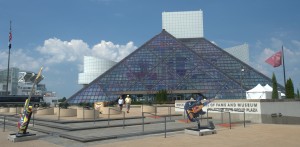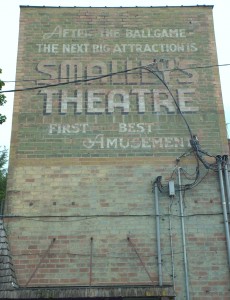
The Rock and Roll Hall of Fame proves one thing: Danny & the Juniors were right:
Rock ‘n roll is here to stay,
it will never die.
It was meant to be that way,
though I don’t know why.
I don’t care what people say,
rock ‘n roll is here to stay.
***
Rock ‘n roll will always be,
I dig it to the end.
It’ll go down in history,
just you wait, my friend.
Rock ‘n roll will always be,
it’ll go down in history.[1]
The hit of 55 years ago foretells history in Cleveland.
***
The Hall of Fame’s curators adopted a philosophy opposite from those at the Cleveland Museum of Art. As I wrote yesterday, the Cleveland Museum wants each item to stand alone, to force the viewer to look at it in isolation.
The Hall of Fame overwhelms the visitor with bits of every day detail: clothes, handbills, posters, snaps, scribblings, hotel room keys…. The debris of life on the road stuffs every case because the contents must suggest music which is not playing.
***
Set on Cleveland’s lakefront, the Hall of Fame is housed in glorious glass pyramids – I.M. Pei’s masterwork, I think.
But, the building’s shell suggests nothing of the early context of the music it enshrines. The awe-inspiring shape is just a guitar case, a utilitarian answer to a storage problem. The broad plaza, the open atrium, the sense of light the building embodies, all bring to mind ‘Gidget’ and ‘Beach Blanket’ movies, not the Winter Dance Party tour of 1959.
The dimly, drably lit galleries which sunlight never reaches suggest the real context in which we heard, absorbed in our cores, Rock ‘n Roll – at night on AM radios or in grotty theaters, gyms or roller rinks.
The music was subversive – our parents were right! Like all conspiracies, it was best carried out in the dark. The Alan Freed exhibit reconstructs an airless, florescent-lit radio studio of the mid 50s to mid 60s where the commanders – Dick Biondi, Juicy Brucie Bradley,[2] Joey Reynolds – spoke to their co-conspirators.
But like the Hall of Fame building itself, the studio is antiseptic, sparkling – something no studio and very few venues of the era were.

Large ashtrays – overflowing, never emptied – and wads of teletype paper or ad copy littered every horizontal surface. Dirt and smoke-residue encrusted every thing – from the soundproof glass to the turntables. The chairs where the disc jockeys sat had ripped cushions and often were broken.
***
The Hall of Fame’s curators wisely relegated music to occasional headphones or snippets in the many videos. As it is, the video sounds overlap unpleasantly. I imagined Iggy Pop melding with Hank Williams….
The Elvis Presley video is fascinating, moving – something this non-fan of The King never thought he’d say. Seeing an exhausted Presley after a gig in a limo coming back to life as his companions suggest riffs made me respect him more than I ever had.
The interview with Sam Phillips, the legendary proprietor of Sun Records, establishes his genius for identifying and producing great rockabilly – Elvis, Jerry Lee, Johnny Cash, Roy Orbison – and R&B singers (Ike Turner). But the more he talks, the stranger, more maniacal he seems.
In contrast, the special exhibit on Rick Nelson emphasized his humility and his deep pride in his music. In context, ‘Garden Party’ seems more a continuation of an important strand of Rock – one that runs up the West Coast from the Four Preps through the Beach Boys and the Eagles to the Decemberists.
***
The film on Cleveland’s own Alan Freed, the disc jockey and promoter who invented the phrase ‘Rock ‘n Roll’, reveals the opportunity the 50s brought to innovate in music, the naivete and cracked idealism of its leaders, and the hypocrisy of the ‘payola’ (pay-to-play) scandals.
Freed apart, the absence of recordings of the disc jockeys who influenced us badly skews the history the Hall of Fame is presenting. You can’t understand the music without understanding its main medium.
The recordings, for instance, of the great Dan Ingram[3] and ‘Cousin Brucie’ Morrow aren’t from their WABC-AM days but from later FM gigs. Worse, they’re snippets. Similarly, Boston’s Arnie ‘Woo Woo’ Ginsburg lacks his unforgettable ‘Night Train’ intro from his early WMEX days.
The lack of on-air recordings reminded me how ephemeral culture, the zeitgeist, is. How can you experience the spirit of an age if you can’t hear it, smell it?
***
The Hall of Fame, unsurprisingly, downplays the role of large media corporations in controlling what got herard. For better or worse, ABC (WABC, WLS) and Westinghouse (WBZ, KDKA, KYW) and MCA (WMCA) shaped our tastes, our visions.
It also downplays the craven exploitation of artists – especially though not exclusively blacks and Hispanics – by record companies and promoters. Only boxing has a sadder, more sordid history. Given ‘the industry’, as insiders called it, this softening, too, is unsurprising.
***
One video outraged me: the Vietnam War’s influence on Rock and my generation. It’s the Dairy Queen version of the Days of Rage.
Worse, the video accompanying the cursory display has Country Joe McDonald speaking the lyrics to ‘Feeling Like I’m Fixing to Die Rag’, the anthem of my time. You’ve got to hear the man; you’ve got to hear the 300,000 (his number) singing with him at Woodstock.
Similarly, alcohol and drugs except as a means to the end, hardly figure.
Cool as Janis Joplin’s Porsche is, Southern Comfort and heroin are much more important to an understanding of her, her music and her time – and ours. The Hall of Fame would better fill the parking space with a display on drugs and alcohol in Rock culture.
***
As with any museum run by semi-intelligent marketers, visitors exit through the gift shop. The Hall of Fame’s loot ranks pretty high in most areas, but off-the-charts in another.
One of the joys of my life has been poking through bins of records and CDs, searching for treasure. In two visits, I’ve only covered a quarter of its CD bins.
This time, I found a CD of original recordings by the fine 60s folk/country songwriter, Billy Edd Wheeler. Neither the great river of merchandise nor his website hinted this reissue existed. If you’ve never heard the originals of ‘Winter Sky’, ‘Coal Tatoo’, ‘Reverend Mr. Black’ or ‘Jackson’, you’ve got a real treat in store – if you can find this CD.[4]
Now, I could complain that the brightly lit Hall of Fame record shop with its views of the Cleveland lakefront and downtown lack the grungy allure of Toronto’s Sam the Record Man or New York’s Sam Goody or London’s Tower Records or Berkeley’s Amoeba Music – all gone save the last. But any day I’ll take clean Cleveland, the music and the very pleasant, smart help.
***
The same may be said for the Rock and Roll Hall of Fame as a whole. It’s a whole lot cleaner – and the ‘adults’ are way nicer — than the Rock ‘n Roll of my real and imagined youth. Nary a whiff of tobacco or wacky-tabacky in Cleveland.
I’ll be back a third time, as soon as my cousins will have us again. For ‘Rock ‘n roll will always be/I dig it to the end.’
Notes
1. ‘Rock ‘n roll is here to stay’, music and Lyrics by David White (1957). I loved this song the first time I heard it. It is ingeniously put together. I transcribed the lyrics from the 1958 hit. An accurate version is not to be found on any site.
2. Check out who wrote the linked Harvard Crimson piece on Bradley: future NY Times Supreme Court reporter, Linda J. Greenhouse.
3. Bar none, Dan Ingram was the greatest disc jockey of the tightly formatted AM top 40 era. No one was quicker with a quip, faster to fill dead air. I will never forget the 30 second introduction to ‘News Briefs five minutest sooner on WABC, New York’ which sent the news reader, the great pro, Fred Foy (announcer for ‘The Lone Ranger’), into uncontrollable laughter. Another day….
4. On these songs and several others, Wheeler is accompanied by a woman with one of the most gorgeous alto voices I’ve ever heard. She was uncredited on the 1966 album and again on the reissue. Who is she?
Recent Comments